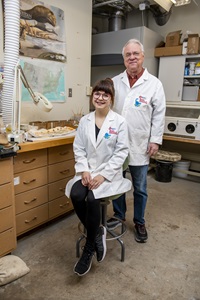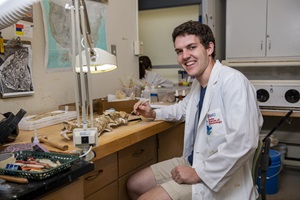Digging into Mysteries of the Past: SMU Students Collaborate with Faculty on New Exhibit
Under the guidance of SMU Professor emeritus of Paleontology Louis Jacobs, fourth year Geology and Human Rights major Evan Snyder and Myria Perez '18, share their experiences assisting with Sea Monsters Unearthed, a new exhibit in the Smithsonian. Snyder and Perez speak about how their work shaped their time on the Hilltop and their post-graduation plans.
Sea Monsters Unearthed, which opened at the Smithsonian on November 9, immerses visitors in a marine environment from the Cretaceous Period, beginning about 145 million years ago and ending about 66 million years ago. Making the exhibit even more exciting for those of us on the Hilltop, it is the result of a long collaboration between SMU Professor emeritus of Paleontology Louis Jacobs, his colleague Michael Polcyn, and others in Angola, Portugal, and the Netherlands. Once the fossils were excavated, Jacobs and Polcyn partnered with research associate Diana Vineyard and over 100 SMU students throughout the past 13 years to clean and preserve the fossils.

Evan Snyder heard about the project through a class during his first year, and thinking that it sounded like a unique chance to gain invaluable work experience and learn new lab techniques, decided to get involved.
Recognizing the important role that museums played in his own life, working on the Sea Monsters Unearthed team allowed Snyder to make important connections between the lab and the world at large. “I often think about the museum exhibits that helped foster my love of science and led me to a degree in Earth Science, and I hope some of the kids that visit the exhibit over the next two years are excited in the same way I was. Working on this exhibit has made me realize how impactful lab work can be and has encouraged me to pursue a career that will impact people, whatever that ends up being.”
Like Snyder, working on the exhibit has shaped more than just Perez’s time on campus; she was able to discover a love of working directly with fossils, and was offered a position as an Assistant Preparator with the Perot Museum of Nature and Science to work on Alaskan dinosaurs and Cretaceous marine reptiles in their new labs after graduating this spring.
Ultimately, Perez credits the time she spent working on the exhibit with helping her not just to prepare for a career, but to discover her passion. “Working on this exhibit has made me realize that I love working with my hands and one-on-one with fossil specimens. I found myself really enjoying the variety associated with fossil prep from using tools like the air scribe to painting reconstructions…This project allowed me to gain once-in-a-lifetime experiences and skills. I have been able to see and be heavily involved in the exhibit-making process. From using 3D segmenting programs, such as Amira 3D Software for Life Sciences, to reconstructing a skeleton from a 22-foot-long mosasaur, I have been exposed to a variety of techniques.”
Much of the process for Snyder involved slow and meticulous work to safely prepare each fossil, but the end result was well worth the process. “I loved working on the jawbone of Prognathadon Kianda during the spring of my sophomore year. It took me most of the semester to free the jaw from the matrix, but it was very satisfying. The teeth are especially neat to work with!”
While the day-to-day work of his experience ranged from basic preparation of the fossils to making casts and 3D models and printed bones, he was also able to participate in the filming of the introductory video for the exhibit and was able to see the intense work that goes into designing an exhibit.
His experience became so much more, as he explains, “I had to learn to trust myself. When working on one-of-a-kind fossils that are millions of years old it’s easy to be paralyzed by fear but I learned to work with confidence and not be afraid of making mistakes.”
Learn more about Sea Monsters UNEARTHED |
